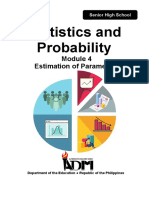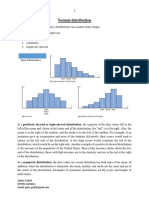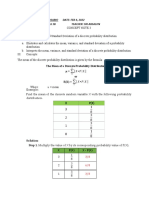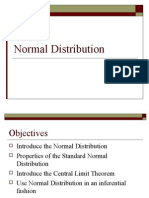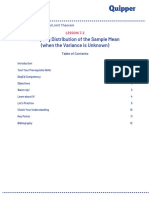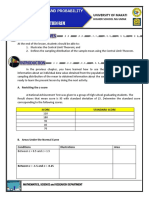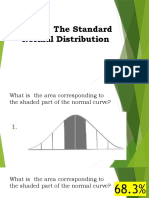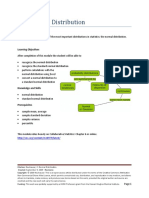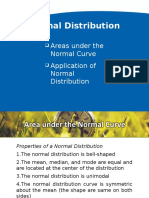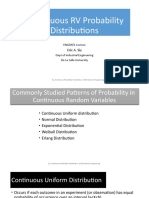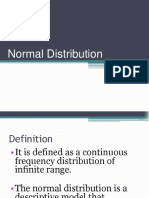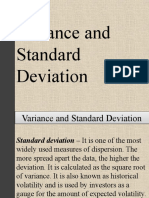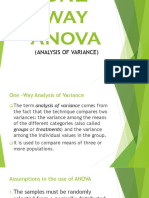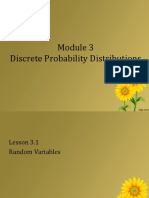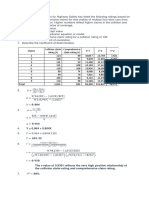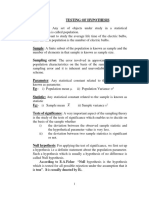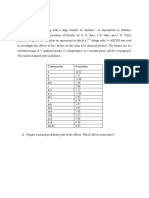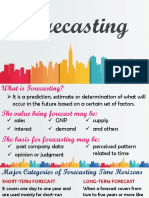Continuous Distributions
Normal Distribution
�Learning Objectives
Probability density function of normal distribution
Standard normal distribution
Recognize normal distribution problems, and know
how to solve them
Decide when to use the normal distribution to
approximate binomial distribution problems, and know
how to work them
Computation of probabilities from the normal
distribution
Use the normal distribution to solve business problems
Testing whether a set of data is normally distributed
Graphical
Analytical
�Continuous Random Variable
Measurement data
Interval level data and ratio level data
Scale data
�Continuous Random Variable
A continuous random variable is a real valued function
that can assume any value on a continuum (can assume
an uncountable number of values)
Sales
Profit
Thickness of an item
Time required to complete a task
Temperature of a solution
Height [all in appropriate units]
These can potentially take on any value depending only
on the ability to precisely and accurately measuring it
�Some Continuous Probability Distributions
Normal
Standard normal
Exponential(1&2)
Uniform
t
Chi-square (2)
F
Tau ()
Cauchy
Gompertz
Log-normal(2&3)
Gamma (2&3)
Beta
Logistic distribution
Loglogistic (2&3)
Weibull(2&3)
Smallest extreme
value
Largest extreme
value
Pareto
�Sampling Distributions
Standard normal (z)
t
Chi-square (2)
F
Tau ()
�Normal Distribution
Probably the most widely known and used of
all distributions is the normal distribution
It fits many human characteristics, such as
height
weight
length
IQ scores
scholastic achievements
years of life expectancy
speed
�Graphic Representation of the Normal Distribution
�Normal Distribution
Many things in nature such as
Plants
Trees
Animals
Insects
Have many characteristics that are
normally distributed
Hence, the name normal
�Normal Distribution
Many variables in business and industry
are also normally distributed. For
example,
annual cost of household insurance
cost per square foot of renting
warehouse space
managers satisfaction on a five-point
scale
amount of fill in soda cans, etc.
Extremely important distribution.
�Normal Distribution
Discovery of the normal curve of errors is generally
credited to mathematician and astronomer Karl Gauss
(1777 1855), who recognized that the errors of
repeated measurement of objects are often normally
distributed.
Thus the normal distribution is sometimes referred to
as the Gaussian distribution or the normal curve of
errors.
Pierre-Simon de Laplace (1749 1827) and Abraham
de Moivre (1667 1754) contributed significantly in the
development of the normal distribution.
�The Normal Distribution
Bell Shaped continuous
Symmetrical about mean
Mean, Median and Mode
are Equal
Location is determined by the
mean,
Spread is determined by the
standard deviation,
The random variable has an
infinite theoretical range:
+ to
f(X)
Mean
= Median
= Mode
�Properties of the Normal Distribution
It is asymptotic to the
horizontal axis.
It is unimodal.
Area represents
probability; Area under
the curve is 1.
It is a family of curves.
�Family of Normal Curves
�Skewness and Kurtosis
Skewness
Skewness=0
Kurtosis
Kurtosis=3
�Moments of a Distribution
The rth moment of a rv X about any
point x=A is defined as
1
=
N
'
r
i =1
f i ( xi A) r
It is known as raw moments
�Moments
The rth moment of a rv X about mean is
defined as
1
r =
N
f (x
i =1
x)
It is known as central moment
�Skewness and Kurtosis
Skewness
Skewness( Sk ) =
Kurtosis
2
3
3
2
4
Kurtosis = 2
2
�Measures of Shape
Skewness
Absence of symmetry
Extreme values in one side of a distribution
Kurtosis
Peakedness of a distribution
Leptokurtic: high and thin
Mesokurtic: normal shape
Platykurtic: flat and spread out
�Symmetrical and Skewness
0.30
0.4
0.25
0.20
0.3
0.15
0.2
0.10
0.05
0.1
0.00
0.0
0
-4
-3
-2
Symmetrical
-1
0
0
10
12
Right or Positively
Skewed
12
10
0
0.70
0.75
0.80
0.85
0.90
0.95
1.00
Left or Negatively
Skewed
�Relationship of Mean, Median and Mode
�Relationship of Mean, Median and Mode
�Relationship of Mean, Median and Mode
�Skewness
If Sk < 0, the distribution is negatively
skewed (skewed to the left).
If Sk = 0, the distribution is symmetric (not
skewed).
If Sk > 0, the distribution is positively
skewed (skewed to the right).
�Types of Kurtosis
Platykurtic Distribution
Leptokurtic Distribution
Mesokurtic Distribution
�More Properties
As x increases numerically, f(x) decreases
rapidly, the maximum probability occurring
at x= and is given by
f(x) max=1/(*sqrt(2))
Linear combination of independent normal
variates is also a normal variate.
�Area Property
P(-<X< +) = 0.6826
P(-2<X< +2) = 0.9544
P(-3<X< +3) = 0.9973
�Probability Density Function (pdf) of Normal
Distribution
The formula for the normal probability density function is
f(x) =
1
2
1 (x )
Where e = the mathematical constant approximated by 2.71
= the mathematical constant approximated by 3.14
= the population mean
= the population standard deviation
x= any value of the continuous random variable, X
�Standardized Normal Distribution
Since there is an infinite number of combinations for
and , then we can generate an infinite family of
curves.
Because of this, it would be impractical to deal with all
of these normal distributions.
Fortunately, a mechanism was developed by which all
normal distributions can be converted into a single
distribution called the z distribution.
This process yields the standardized normal
distribution (or curve).
�Transformation
The conversion formula for any x value of a
given normal distribution is given below. It is
called the z-score.
z=
A z-score gives the number of standard
deviations that a value x, is above or below the
mean.
�Probability Density Function of
Standardized Normal Distribution
The formula for the standardized normal
probability density function is
f(Z) =
1
(1/2)Z 2
e
2
Where e = the mathematical constant approximated by 2.71828
= the mathematical constant approximated by 3.14159
Z = any value of the standardized normal distribution
�Standardized Normal Distribution
If X is normally distributed with a mean of and a
standard deviation of , then the z-score will also be
normally distributed with
mean of 0 and
standard deviation of 1
Since we can convert to this standard normal
distribution, tables have been generated for this
standard normal distribution which will enable us to
determine probabilities for normal variables
The tables in the text are set up to give the probabilities
between z = 0 and some other z value, z0 say
�Probability
The probability that a rv X lies in the
interval (-, +) is given by
P( < X < + ) =
f ( x)dx
�Standardized Normal Distribution
��Applying the Z Formula
X is normally distributed with = 485, and = 105
P( 485 X 600 ) = P( 0 Z 1.10 ) =. 3643
For X = 485,
X - 485 485
=
=0
Z=
105
0.00
0.01
0.02
0.00
0.10
0.0000 0.0040 0.0080
0.0398 0.0438 0.0478
For X = 600,
1.00
0.3413 0.3438 0.3461
X - 600 485
=
= 1.10
Z=
105
1.10
0.3643 0.3665 0.3686
1.20
0.3849 0.3869 0.3888
�Applying the Z Formula
Example 1
X is normally distributed with = 494, and = 100
P( X 550) = P( Z 0.56) = .7123
For X = 550
X - 550 494
Z=
=
= 0.56
100
0.5 + 0.2123 = 0.7123
�Example 2
�Applying the Z Formula
Example 3
X is normally distributed with = 494, and = 100
P( X > 700) = P( Z > 2.06) = .0197
For X = 700
X - 700 494
Z=
=
= 2.06
100
0.5 0.4803 = 0.0197
�Applying the Z Formula
Example 4
X is normally distributed with = 494, and = 100
P(300 X 600) = P(1.94 Z 1.06) = .8292
For X = 300
X - 300 494
Z=
=
= 1.94
100
For X = 600
X - 600 494
Z=
=
= 1.06
100
0.4738+ 0.3554 = 0.8292
�Normal Approximation
of the Binomial Distribution
n=10 p=.2
n=10
p=.2
�Normal Approximation
of the Binomial Distribution
The normal distribution can be used to
approximate binomial probabilities.
Procedure
Convert binomial parameters to normal
parameters.
Approximation is good if both np>5 and nq>5
Does the interval 3 lie between 0 and n?
If so, continue; otherwise, do not use the
normal approximation.
Correct for continuity.
Solve the normal distribution problem.
�Normal Approximation of Binomial:
Parameter Conversion
Conversion equations
= n p
= n pq
Conversion example:
Given that X has a binomial distribution, find
P( X 25| n = 60 and p =. 30 ).
= n p = (60 )(. 30 ) = 18
= n p q = (60 )(. 30 )(. 70 ) = 3. 55
�Normal Approximation of Binomial:
Interval Check
3 = 18 3(355
. ) = 18 10.65
3 = 7.35
+ 3 = 28.65
10
20
30
40
50
60
n
70
�Graph of the Binomial Problem:
n = 60, p = 0.3
0.12
0.10
P(x)
0.08
0.06
0.04
0.02
0.00
10
15
20
x
25
30
�Normal Approximation of Binomial:
Correcting for Continuity
Values
Being
Determined
Correction
X>
X
X<
X
X
<X<
+.50
-.50
-.50
+.50
-.50 and +.50
+.50 and -.50
The binomial probability,
P( X 25| n = 60 and p =. 30 )
is approximated by the normal probability
P(X 24.5| = 18 and = 3. 55).
�Normal Approximation of Binomial:
Computations
X
P(X)
25
26
27
28
29
30
31
32
33
Total
0.0167
0.0096
0.0052
0.0026
0.0012
0.0005
0.0002
0.0001
0.0000
0.0361
The normal approximation,
. )
P(X 24.5| = 18 and = 355
24.5 18
= P Z
.
355
. )
= P( Z 183
. )
=.5 P( 0 Z 183
=.5.4664
=.0336
�Learning Continues
